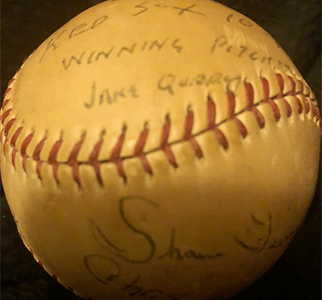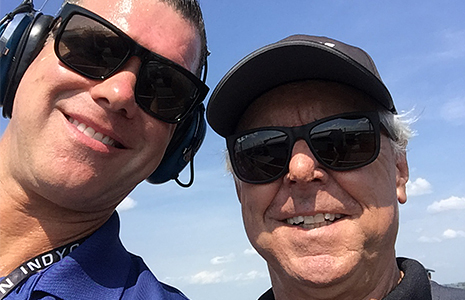The Sports Illustrated photo of Dwight Gooden was what I envisioned each time I released the ball. I still remember what the caption said. There, under the photo of the New York Mets’ strikeout ace, unleashing another zinger that would lead to another of his 276 rookie strikeouts was the caption: “Ever look down the barrel of a loaded gun?”
That’s what I saw as I gunned down the A’s of Allisonville Little League. It was a murderer’s row of Craig Fletchall, Tom Hadley and Burke Fox, each fanning the only breeze created on that warm summer day of 1985 in Indianapolis. Near perfection on the mound, that led my Red Sox to an upset victory – the kind of feat that becomes legendary talk over Sno Cones and Astro pops. At least until the next game.
 It was the lone on-diamond highlight of my Little League career. I was a below-average baseball player, but for that day – the only day – the gods of the pastime smiled down upon me. I was rewarded with a heroic afternoon, an extra ticket to the postgame snack bar and a signed game ball from all my teammates. I still have that ball to this day, a joyous reminder of the day my teammates thanked me for my one job well done.
It was the lone on-diamond highlight of my Little League career. I was a below-average baseball player, but for that day – the only day – the gods of the pastime smiled down upon me. I was rewarded with a heroic afternoon, an extra ticket to the postgame snack bar and a signed game ball from all my teammates. I still have that ball to this day, a joyous reminder of the day my teammates thanked me for my one job well done.
It came a year after my greatest moment in Little League. A moment when I took the day off.
It was the day of the 1984 Indianapolis 500 Festival parade and my world of extracurriculars finally collided. The conundrum: line up with my Red Sox for a tilt against the mighty Twins or help my Cub Scout troop with “seating patrol” at the parade. It was an easy decision. The team wasn’t gonna miss a bench warmer like me. And it was the parade of the Indy 500. Decision made.
We unfolded chairs and directed people to their seats, and like the day a year later when I transported myself into Doc Gooden, I felt in control. And then it happened.
The balloon above the cars announced who was coming next in the parade. “Row 1,” it read. And there, on the back of the convertible Pontiac Fieros, they sat: The defending winner Tom Sneva on pole; Howdy Holmes, the man who drove the Jiffy Brownie Mix car, in the middle; and, on the outside – my side – was the smile of Rick Mears.
That’s when I said it. “Rick! I drew you in my family pool! If you win, I get four dollars!”
At that moment, May 26, 1984, on Pennsylvania Street in downtown Indianapolis, was the very first time an Indy 500 driver spoke to me. “I’ll try to get you your money!” Rick shouted back. They were the first words ever spoken to me by “The Rocket.” In terms of words of self-promotion or radiant confidence, they were also the last.
Fast forward to July 19, 2014, Toronto, Ontario, Canada. There, we huddled atop the Enercare Centre, overlooking Turn 1 of the Honda Indy Toronto, waiting out a rain delay and killing time with trivia and jokes. It was me, calling the course for my post with the Advance Auto Parts INDYCAR Radio Network, and most of the team spotters.
 My question was relatively tame: “Who are the only two men to have won the Indy 500 in three decades?”
My question was relatively tame: “Who are the only two men to have won the Indy 500 in three decades?”
Bobby Unser’s name came quickly (1968, ‘75 and ‘81), but the second was drawing blanks. Tony Kanaan’s spotter was stumped. Mike Conway’s helper was bewildered. The voice that speaks into Scott Dixon’s helmet was speechless. The man who served as extra eyes for Helio Castroneves stared at me incredulously. Finally, I asked if he wanted to give the answer.
“I’m not real comfortable with that,” Mears told me. “I don’t think I’m eligible to answer.”
There he was, the 1979, ‘84, ‘88 and ‘91 Indy 500 winner, embarrassed to speak of his own accomplishments.
That’s what I’ve come to know of Rick Mears. Perhaps the greatest driver in Indy 500 history, Mears won three series titles, claimed 68 podiums, 29 career Indy car wins and took pole at Indy a record six times. But when you try to talk about his greatness, you can’t pull it out of him.
He’s been a quiet observer for Team Penske, both literally and figuratively. At the 2011 Grand Prix of Baltimore, I shared a scissor lift with Mears. Me calling the radio play-by-play and Rick spotting the race for Castroneves. He was a quiet presence; as quiet, at least, as a giant of the sport can be. I inquired after the race why he seemed relatively docile on his headsets.
“Helio’s a pro,” he said. “Unless there’s trouble he can’t see, he doesn’t need me to bother him a whole lot.”
Castroneves is quick to tell a different story. “He’s a hero to me,” the Brazilian once told me. “To be able to talk to him is amazing. I learn something new every time.”
With each INDYCAR race, there he is. Fraternizing with the other spotters, many of whom are part-time employees thrilled to have carved a niche that allows them time at a racetrack. Right there with them, listening in but rarely bending anyone’s ear, stands the man who could bend a wheel as well as anyone who has ever strapped into a cockpit.
 He’s always happy to talk, just not always about himself. In 2014, atop the press box at Iowa Speedway, I asked him the best thing about winning the Indy 500. His answer was brilliant. His favorite part was pulling the car into victory lane and seeing each member of his team, recalling what each man had done to provide him the fastest car of the day. He didn’t think about passing Michael Andretti on the outside of Turn 1. He didn’t reflect on battling with Sneva or dueling with Al Unser or holding off Bobby Unser. He thought about guys that greased springs and caressed bearings and grabbed fuel hoses. The Rocket was only interested in the trajectory of those along for the ride.
He’s always happy to talk, just not always about himself. In 2014, atop the press box at Iowa Speedway, I asked him the best thing about winning the Indy 500. His answer was brilliant. His favorite part was pulling the car into victory lane and seeing each member of his team, recalling what each man had done to provide him the fastest car of the day. He didn’t think about passing Michael Andretti on the outside of Turn 1. He didn’t reflect on battling with Sneva or dueling with Al Unser or holding off Bobby Unser. He thought about guys that greased springs and caressed bearings and grabbed fuel hoses. The Rocket was only interested in the trajectory of those along for the ride.
He told me once the humility comes from his upbringing. His parents instilled in him the discipline to be accountable for his mistakes but aware of others’ roles in his success.
Perhaps I best understood when I broke a cardinal media rule in getting his autograph. I had a personal project to get a helmet signed by every living Indy 500 winner and I looked down at Mears’ signature when he added it to the helmet. “Thanks,” it read after his name – the same way he signs all his autographs.
I asked Mears why he thanked me. If not for fans, I was told, racing would never be possible.
The helmet sits displayed next to the baseball that defined my one shining moment.
One is a reminder of the day a team thanked their unlikely victor. The other a reminder of a champion who never looked past his team.